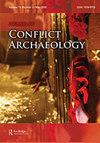西班牙内战中的联合武装战争:对法塔雷拉山脊共和军防线的攻击
IF 0.6
0 ARCHAEOLOGY
引用次数: 6
摘要
就战争方法而言,西班牙内战(1936-39)传统上被视为第一次世界大战和第二次世界大战之间的过渡。这个想法是基于来自德国、意大利和苏联的指定观察员撰写的几份报告。当然,这些军队的一些战术和装备在这场冲突中首次出现。然而,这种观点提出了几个问题,因为在西班牙战场上观察到的经验和战术往往与第二次世界大战第一阶段的情况不同。创新是否被各方和各单位采用?新的战术如何影响冲突的结果?哪些战术经过测试后被抛弃,转而采用更好的战术?考虑到这场战争的特殊性,仅凭文字来源很难解决这些问题。为了提高我们对战争演变的理解,我们需要将文本来源与考古数据和空间分析相结合,并整合知识。本研究考察了在埃布罗战役(1938)的最后阶段对法塔雷拉岭共和党阵地的攻击。特别是,通过对考古和文本资源的空间分析,该作品探讨了在战争的最后几个月里,联合武器战争的应用水平。综合方法的使用使我们能够重建交战,并为冲突期间战术和防御工事的演变提供了有趣的见解。本文章由计算机程序翻译,如有差异,请以英文原文为准。
Combined Arms Warfare in the Spanish Civil War: The Assault on the Republican Defence Line at Fatarella Ridge
Abstract In terms of approaches to warfare, the Spanish Civil War (1936–39) has traditionally been seen as a transition between the First and Second World Wars. The idea is based on several reports written by designated observers from Germany, Italy and the Soviet Union. Certainly, some of the tactics and equipment of these armies made their first appearance during this conflict. However, this view raises several questions, as the experience and tactics observed in the Spanish battlefields often do not match those seen during the first phases of the Second World War. Were the innovations adopted by all sides and units? How did the new tactics influence the outcome of the conflict? Which tactics were tested and discarded for better ones? It is difficult to address these questions using only textual sources, given the particularities of this war. To improve our understanding of the evolution of warfare, we need to combine textual sources with archaeological data and spatial analysis, and integrate the knowledge. This study examines the assault on Republican positions at Fatarella Ridge during the last phase of the Battle of the Ebro (1938). In particular, the work explores, using spatial analysis of archaeological and textual sources, the level at which combined arms warfare was applied during the final months of the war. The use of an integrated methodology has allowed us to reconstruct the engagement and provides interesting insights into the evolution of tactics and fortification during this conflict.
求助全文
通过发布文献求助,成功后即可免费获取论文全文。
去求助
来源期刊

Journal of Conflict Archaeology
ARCHAEOLOGY-
CiteScore
0.80
自引率
50.00%
发文量
8
期刊介绍:
The Journal of Conflict Archaeology is an English-language journal devoted to the battlefield and military archaeology and other spheres of conflict archaeology, covering all periods with a worldwide scope. Additional spheres of interest will include the archaeology of industrial and popular protest; contested landscapes and monuments; nationalism and colonialism; class conflict; the origins of conflict; forensic applications in war-zones; and human rights cases. Themed issues will carry papers on current research; subject and period overviews; fieldwork and excavation reports-interim and final reports; artifact studies; scientific applications; technique evaluations; conference summaries; and book reviews.
 求助内容:
求助内容: 应助结果提醒方式:
应助结果提醒方式:


